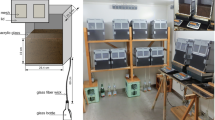Abstract
Purpose
Bricks are regularly found in urban soils where they can strongly impact soil properties. The purpose of this study is to investigate abundance, especially in the fine earth fraction, and properties of bricks in urban soils, focusing on rooting, plant nutrition and contamination.
Materials and methods
Three different urban soils from the city of Berlin have been studied for their brick contents in the coarse and fine earth fractions by hand sorting. Light (LM) and scanning electron microscopy (SEM) was employed to investigate bricks for proofs of rooting. Third, CEC, pH, EC, Corg, nutrient and contaminant storage and availability have been investigated for bricks and the fine earth fractions of the corresponding soil horizons.
Results and discussion
The fine earth fractions of the investigated soils contain 3 to 5 % of bricks, while the coarse fractions contain up to 50 %. The LM and SEM micrographs made the proof that roots enter brick pores or attach to brick surfaces. Therefore, they can use the water and nutrients stored in bricks and bypass pore system discontinuities between bricks and surrounding soil. The CEC of bricks is grain size dependent and reaches a maximum of 6 cmolc kg−1 for particles smaller than 0.063 mm. This dependency is the result of the restricted diffusion into the brick pore system due to the short shaking time in the CEC analysis protocol and of the rising surface with decreasing particle size. From the nutrient storage and availability, we conclude that bricks can better supply plants with K, Mg, Ca and S than the investigated sandy bulk soil.
Conclusions
The nutrient availability from bricks is low compared to control soils, except for Ca and S. Because of the water and nutrient storage, low contamination status and the possible rooting of bricks, they can be used for amelioration of poor sandy soils and for constructed Technosols, preferably employed in small grain sizes.



Similar content being viewed by others
References
Blume H-P, Runge M (1978) Genese und Ökologie innerstädtischer Böden aus Bauschutt. Zeitschrift für Pflanzenernährung und Bodenkunde 141:727–740
BMELV (2009) Handbuch forstliche Analytik online: www.bmelv.de/SharedDocs/Downloads/Landwirtschaft/Wald-Jagd/Bodenzustandserhebung/Handbuch/HandbuchForstanalytikKomplett.pdf?__blob=publicationFile, pp 568. Accessed 7 July 2012
Bullock P, Gregory PJ (1991) Soils in the urban environment. Blackwell, London, 174 p
Campbell JWP, Pryce W (2003) Backstein - eine Architekturgeschichte. Knesebeck Verlags KG, München
Carmeliet J, Descamps F, Houvenaghel G (1999) A multiscale network model for simulating moisture transfer properties of porous media. Transport Porous Media 35:67–88
El Khalil H, Schwartz C, El Hamiani O, Kubiniok J, Morel JL, Boularbah A (2008) Contribution of technic materials to the mobile fraction of metals in urban soils in Marrakech (Morocco). J Soils Sediments 8(1):17–22
GCI and AKS (1998) Hydrogeologisches Strukturmodell für das Wasserwerk Tiefwerder. Gutachten im Auftrag der Berliner Wasserbetriebe und der Senatsverwaltung für Stadtentwicklung, Königs Wusterhausen & Frankfurt/O. (not published)
Goksu HY, Schwenk P, Semiochkina N (2001) Investigation of the thermal stability of 210 degrees C TL peak of quartz and dating the components of terrazzo from the monastery church of Tegernsee. Radiat Meas 33:785–792
Hiller DA, Meuser H (1998) Urbane Böden. Springer, Berlin
Jang YC, Townsend T (2001) Sulfate leaching from recovered construction and demolition debris fines. Adv Environ Res 5(3):203–217
Jongmans AG, van Breemen N, Lundstrom U, van Hees PAW, Finlay RD, Srinivasan M, Unestam T, Giesler R, Melkerud PA, Olsson A (1997) Rock-eating fungi. Nature 389(6652):682–683
Koele N, Hildebrand EE (2008) The ecological significance of the coarse soil fraction for Picea abies (L.) Karst. seedling nutrition. Plant Soil 312(1–2):163–174
Marschner H (1986) Mineral nutrition in higher plants. Academic, London, p 674
Mekiffer B (2008) Eigenschaften urbaner Böden Berlins - statistische Auswertung von Gutachtendaten und Fallbeispielen. Dissertation, Technische Universitaet Berlin, Berlin, p 141
Morel J, Schwartz C, Florentin L, de Kimpe C (2005) Urban soils. In: Hillel D (ed) Encyclopedia of soils in the environment. Elsevier, Oxford, pp 202–208
Plagge R, Teutsch A (2003) Water retention transfer functions of ceramic bricks of the Dresden building stock. In: Carmeliet J, Hens H, Vermeir G (eds) Research in Building Physics,Proceedings of the 2nd international conference on building physics, September 2003, Taylor and Francis, London, pp 197–206
Ralph EK, Han MC (1966) Dating of pottery by thermoluminescence. Nature 210(5033):245
Richards LA (ed) (1954) Diagnosis and improvement of saline and alkali soils. USDA Agricultural Handbook 60. online: http://www.ars.usda.gov/Services/docs.htm?docid=10158page=2. Accessed 1 Dec 2011
Rossiter DG (2007) Classification of urban and industrial soils in the World Reference Base for Soil Resources. J Soils Sediments 7:96–100
Scheffer F, Schachtschabel P (1998) Lehrbuch der Bodenkunde. Ferdinand Enke Verlag, Stuttgart, p 494
Schonsky H, Peters A, Lang F, Mekiffer B, Wessolek G (2012) Sulfate transport and release in technogenic soil substrates: experiments and numerical modeling. J Soils Sediments (in press)
Séré G, Schwartz C, Ouvrard S, Sauvage C, Renat JC, Morel JL (2008) Soil construction: a step for ecological reclamation of derelict lands. J Soils Sediments 8(2):130–136
Siebert (1956) Geologische und hydrogeologische Untersuchungen im Bereich des Wasserwerks Grunewald.- Berliner Wasserwerke (not published)
Trinks S, Stoffregen H, Wessolek G (2007) Hydraulische Eigenschaften von Trümmerschuttböden, Tagung der Deutschen Bodenkundlichen Gesellschaft 2007 in Dresden. Mitteilungen der Deutschen Bodenkundlichen Gesellschaft 106(1):141–142
Waisel Y, Eshel A, Kafkaki U (1991) Plant roots: the hidden half. Dekker, New York, p 948
Wintle AG (1997) Luminescence dating: laboratory procedures and protocols. Radiat Meas 27(5–6):769–817
Acknowledgments
We thank the centre for microscopy of the Technische Universität especially Irene Preuss and Joerg Nissen for their help on the microscopy images. We thank the German Science Foundation (DFG WE 1125/26-1) and the German and French academic exchange services (DAAD and EGIDE) for funding.
Author information
Authors and Affiliations
Corresponding author
Additional information
Responsible editor: Jean Louis Morel
Rights and permissions
About this article
Cite this article
Nehls, T., Rokia, S., Mekiffer, B. et al. Contribution of bricks to urban soil properties. J Soils Sediments 13, 575–584 (2013). https://doi.org/10.1007/s11368-012-0559-0
Received:
Accepted:
Published:
Issue Date:
DOI: https://doi.org/10.1007/s11368-012-0559-0




